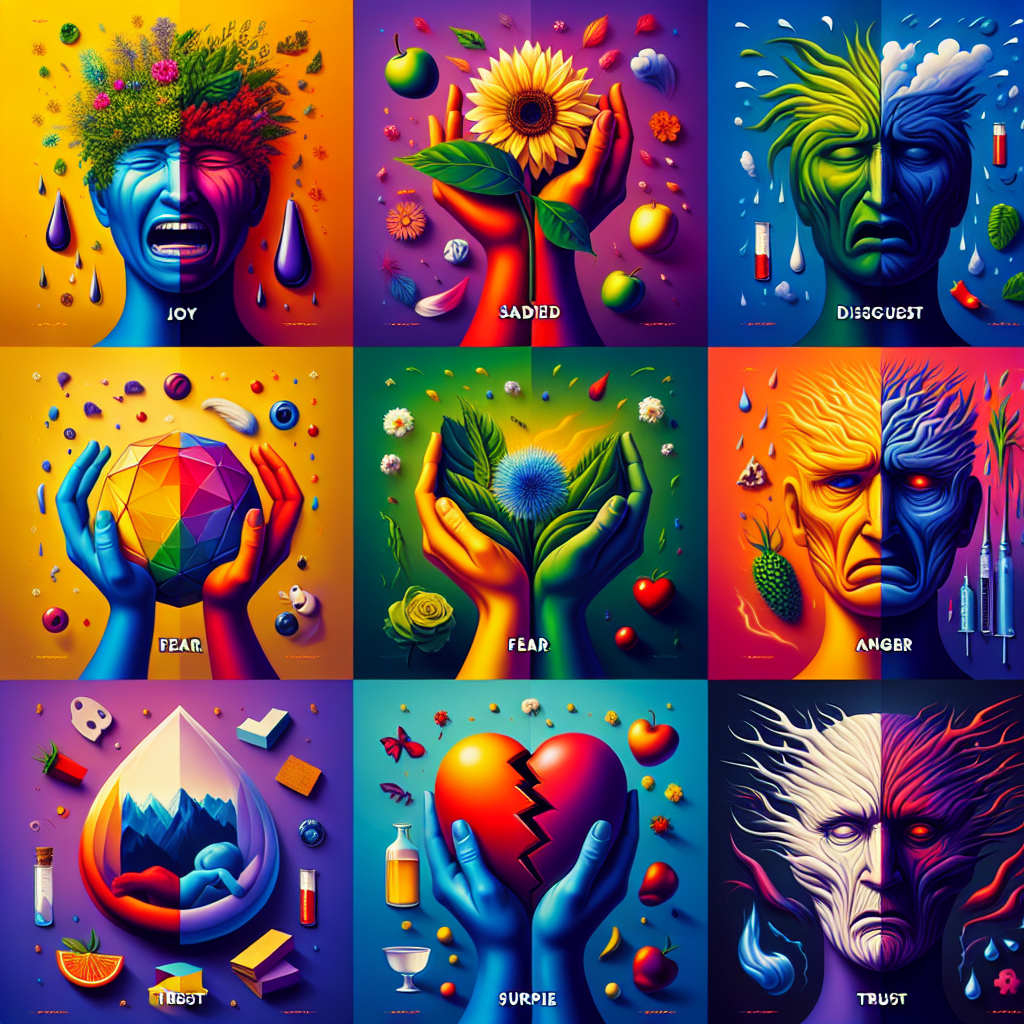Hey there! Have you ever wondered about the most common emotions we experience? Well, today we’re going to explore the top 8 emotions that people commonly encounter in their everyday lives. From joy and sadness to fear and anger, these emotions play a significant role in shaping our experiences and interactions with the world around us. So, get ready to discover the fascinating world of emotions and learn more about how they impact our lives. Let’s dive right in!

Joy
Definition
Joy is an intense feeling of happiness and contentment. It is a positive emotion that brings a sense of pleasure, fulfillment, and optimism. It often arises from achieving goals, experiencing success, or receiving good news. Joy is a state of mind that can bring about a sense of euphoria and can be contagious, spreading happiness to those around you.
Characteristics
When you experience joy, you may feel a sense of elation and an increased level of energy. It can make you feel lively, enthusiastic, and uplifted. Joy is often accompanied by laughter, smiling, and a general sense of well-being. Your heart feels light, your body feels relaxed, and you may have a heightened sense of gratitude for the positive experiences in your life.
Causes
Joy can stem from a variety of sources. It can be triggered by achievements, such as reaching a personal goal, receiving recognition for your accomplishments, or overcoming challenges. Joy can also arise from positive events, such as celebrations, spending time with loved ones, or participating in activities that bring you pleasure. Additionally, joy can emerge from moments of beauty, such as witnessing a breathtaking sunset or listening to uplifting music.
Effects
Experiencing joy has numerous beneficial effects on your overall well-being. It can enhance your mental health by reducing stress and anxiety. Joy can also strengthen your immune system and improve your physical health. It promotes a positive outlook on life, increasing your motivation, productivity, and resilience. Furthermore, joy fosters social connections, as it attracts positive interactions and can strengthen relationships.
Expression
Joy is often expressed through various non-verbal cues. Smiling, laughing, and spontaneous bursts of excitement are common physical manifestations of joy. You may also exhibit increased energy levels and engage in playful behaviors. Sharing your joy with others through gestures, hugs, or supportive words can further amplify the positive impact of this emotion.
Coping Strategies
To cultivate and maintain joy, it is important to engage in activities that bring you happiness and fulfillment. These can include pursuing hobbies, spending quality time with loved ones, practicing gratitude, and celebrating your achievements. Adopting a positive mindset and focusing on the present moment can also help you experience more joy in your daily life. Additionally, finding ways to spread joy to others, such as through acts of kindness or supporting charitable causes, can contribute to your own sense of joy and satisfaction.
Sadness
Definition
Sadness is a normal human emotion characterized by feelings of sorrow, grief, or unhappiness. It is a natural response to loss, disappointment, or painful experiences. Sadness can vary in intensity, ranging from mild discomfort to profound distress. While it may be unpleasant, sadness serves an important purpose in helping us process and heal from emotional wounds.
Characteristics
When you are feeling sad, you may experience a range of emotional and physical symptoms. These can include tearfulness, a heavy or empty feeling in the chest, low energy levels, changes in appetite or sleep patterns, and a lack of interest in activities you typically enjoy. Sadness often leads to introspection and a withdrawal from social interactions, as you may feel a need to retreat and heal emotionally.
Causes
Sadness can arise from a variety of situations and events. Loss, such as the death of a loved one, the end of a relationship, or the loss of a job, can trigger profound sadness. Disappointment, failure, or unmet expectations can also lead to feelings of sadness. Traumatic experiences, personal setbacks, or witnessing the suffering of others can also evoke sadness.
Effects
Sadness can have both short-term and long-term effects on your well-being. In the short-term, it may impact your mood, energy levels, and ability to concentrate. You may also experience a decreased motivation to engage in activities you typically enjoy. Long-term sadness can contribute to the development of mental health issues, such as depression or anxiety. It is important to address and process feelings of sadness to prevent them from becoming chronic or overwhelming.
Expression
Sadness is often expressed through non-verbal cues and changes in behavior. Crying, a loss of interest or enthusiasm, a subdued demeanor, and a slower pace of movement are common expressions of sadness. You may also choose to isolate yourself or seek solitude during periods of sadness.
Coping Strategies
To cope with sadness, it is important to give yourself permission to feel and process your emotions. It can be helpful to engage in self-care activities, such as getting enough rest and practicing relaxation techniques. Talking openly about your feelings with trusted friends or seeking professional support can also aid in the healing process. Engaging in activities that bring you comfort or joy, such as listening to music, spending time in nature, or engaging in creative outlets, can provide solace during times of sadness.
Anger
Definition
Anger is a powerful emotion characterized by feelings of displeasure, irritation, or rage. It arises when you perceive a threat, injustice, or frustration. Anger can range from a mild annoyance to intense fury and can have both emotional and physical manifestations.
Characteristics
When you experience anger, you may feel a surge of energy and a heightened state of arousal. Your heart rate may increase, your muscles may tense, and your breathing may become rapid and shallow. Emotionally, anger can make you feel a sense of injustice, indignation, or a desire for retaliation. It can also sharpen your focus and increase your determination to take action.
Causes
Anger can be triggered by a variety of circumstances. These can include feeling threatened or attacked, experiencing a sense of unfairness or injustice, or perceiving a violation of your boundaries or values. Frustration, unresolved conflicts, or unmet needs can also lead to feelings of anger.
Effects
Experiencing anger can have both immediate and long-term effects. In the short-term, anger can provide a burst of energy and motivation to address the perceived issue. However, if anger is not managed constructively, it can lead to aggression, strained relationships, and negative consequences. Long-term, chronic anger can contribute to various health problems, such as high blood pressure, heart disease, and impaired immune function.
Expression
Anger can be expressed in numerous ways, both verbally and non-verbally. It may involve shouting, aggressive gestures, or physical acts of violence. Non-verbal cues, such as a clenched jaw, tense posture, or a confrontational facial expression, can also convey anger.
Coping Strategies
Effectively managing anger is crucial to prevent it from causing harm to yourself or others. Taking a step back and allowing yourself to cool down before reacting can help you respond more thoughtfully. Engaging in relaxation techniques, such as deep breathing or mindfulness exercises, can also diffuse anger. Expressing your feelings calmly and assertively, without resorting to aggression, can facilitate healthy communication and conflict resolution. Seeking professional help, such as anger management therapy, can provide additional tools and strategies for managing anger in a constructive manner.
Fear
Definition
Fear is an intense emotional response to a perceived threat or danger. It is a natural, instinctual response that triggers the body’s “fight-or-flight” response, preparing you to either confront or escape the threat. Fear can be a protective mechanism, helping you to stay safe by avoiding potentially harmful situations.
Characteristics
When you experience fear, your body undergoes physiological changes to prepare you for action. These can include increased heart rate, rapid breathing, sweaty palms, and muscle tension. Emotionally, fear can cause a sense of unease, anxiety, or apprehension. It is often accompanied by a hyper-vigilance towards potential threats and a desire to seek safety and security.
Causes
Fear can be triggered by a variety of factors. It can arise from real, immediate threats, such as physical harm or danger. Fear can also stem from perceived threats, such as social rejection, failure, or uncertainty about the future. Past traumatic experiences or phobias can also contribute to the development of fear.
Effects
Fear can have a profound impact on your behavior and well-being. It can lead to avoidance of certain situations or activities that are perceived as threatening. Chronic fear can contribute to the development of anxiety disorders and other mental health conditions. Additionally, fear can limit your sense of freedom and prevent you from fully engaging in life experiences.
Expression
Fear is often expressed through visible signs of distress. It may involve physical manifestations, such as trembling, sweating, or a frozen posture. Facial expressions associated with fear can include widened eyes, raised eyebrows, and a tense or alarmed expression. Verbal expressions may involve crying, screaming, or expressing a sense of urgency.
Coping Strategies
When dealing with fear, it is important to address the underlying sources of anxiety and seek support if needed. Educating yourself about the perceived threat can help alleviate fears by providing a greater understanding of the situation. Building resilience through practices such as mindfulness, meditation, and deep breathing exercises can also help you manage fear. Seeking professional therapy or counseling can provide additional tools and support to overcome fear and move towards a more balanced and confident state of mind.

Surprise
Definition
Surprise is an emotional response to unexpected or unfamiliar events. It is a brief, intense emotion that arises when something unexpected disrupts your expectations or existing beliefs. Surprise can either be positive or negative in nature and can vary in intensity.
Characteristics
When you experience surprise, you may feel a momentary sense of astonishment, followed by a cognitive processing of the unexpected event. Physically, surprise can be accompanied by raised eyebrows, widened eyes, and an open mouth. Surprise evokes a heightened state of alertness and curiosity, as you try to make sense of the unexpected experience.
Causes
Surprise can stem from a variety of circumstances. It can result from unexpected events or outcomes, such as surprise parties, sudden changes in plans, or receiving surprising news. Surprise can also arise from encountering something new or unfamiliar, challenging your existing beliefs or assumptions.
Effects
Surprise has both immediate and long-term effects. In the short-term, surprise can increase your attention and focus, as you try to process and make sense of the unexpected event. It can also stimulate your curiosity and desire to explore new possibilities. Long-term, surprise can facilitate learning and personal growth, as it encourages you to adapt and expand your understanding of the world.
Expression
Surprise is often expressed through visible cues. Facial expressions associated with surprise can include widened eyes, raised eyebrows, and an open or slackened mouth. Verbal expressions may involve exclamations of surprise or statements expressing disbelief.
Coping Strategies
To cope with surprise, it can be helpful to embrace a mindset of curiosity and openness to new experiences. Engaging in activities that challenge your assumptions or expose you to unexpected situations can foster adaptability and resilience. Reflecting on surprising events and seeking meaning or lessons in them can also contribute to personal growth and development.
Disgust
Definition
Disgust is an emotion characterized by feelings of revulsion, aversion, or distaste. It arises when you encounter something that is perceived as offensive, unclean, or morally repugnant. Disgust serves as a protective mechanism, helping you to avoid potentially harmful substances or behaviors.
Characteristics
When you experience disgust, you may feel a physical and emotional reaction of repulsion. Physically, disgust can be accompanied by a wrinkled nose, a turning away of the head, or a feeling of queasiness. Emotionally, disgust can evoke feelings of nausea, contempt, or a desire to distance oneself from the source of disgust.
Causes
Disgust can be triggered by a variety of factors. It can arise from encountering unpleasant smells, tastes, or textures. Disgust can also be elicited by witnessing unhygienic or unsanitary conditions, engaging in morally or socially unacceptable behavior, or perceiving a violation of personal norms and values.
Effects
Experiencing disgust can lead to avoidance behavior, as you seek to distance yourself from the perceived source of disgust. It can also influence your attitudes and beliefs, shaping your preferences and guiding your choices. Disgust can contribute to the development of moral judgments and help enforce societal norms and standards.
Expression
Disgust is often expressed through visible cues. Facial expressions associated with disgust can include a wrinkled nose, a furrowed brow, and a curled upper lip. Non-verbal cues, such as turning away or recoiling, can also convey disgust.
Coping Strategies
To cope with disgust, it is important to understand the underlying reasons and triggers for your emotional response. Identifying and addressing any irrational or exaggerated disgust reactions can help you separate genuine threats from harmless situations. Engaging in practices such as breathing exercises, cognitive reframing, and exposure therapy can help you manage and reduce disgust responses. Seeking professional guidance, such as therapy or counseling, can provide further support in addressing specific disgust-related issues.

Contempt
Definition
Contempt is an emotion characterized by a feeling of superiority, scorn, or disrespect towards others. It arises when you perceive someone as inferior, immoral, or deserving of disdain. Contempt involves a sense of superiority and an inclination to devalue or belittle others.
Characteristics
When you experience contempt, you may feel a sense of moral superiority and a belief that you are better than the person or group you hold in contempt. Contempt is often accompanied by an arrogant or dismissive attitude. Physically, it may be expressed through body language cues such as a raised chin, narrowed eyes, or a sneering facial expression.
Causes
Contempt can be triggered by various factors. It often arises from a perceived violation of social norms, values, or ethical standards. Contempt can develop towards individuals who are seen as incompetent, dishonest, or morally corrupt. It can also be a response to behavior that is considered socially undesirable or inappropriate.
Effects
Experiencing contempt can have negative consequences for both the individual expressing contempt and the recipient of it. Contempt can damage relationships and erode trust and respect. It can also contribute to social divisiveness and hostility. Holding contempt towards others can lead to isolation and hinder personal growth and development.
Expression
Contempt is often expressed through visible cues. Facial expressions associated with contempt can include a raised chin, narrowed eyes, and a tight-lipped or sneering mouth. Non-verbal cues, such as eye-rolling, dismissive gestures, or a condescending tone of voice, can also convey contempt.
Coping Strategies
To cope with feelings of contempt, it is important to challenge and examine the underlying beliefs and assumptions that contribute to this emotion. Practicing empathy and seeking to understand others’ perspectives can help reduce feelings of superiority and foster greater compassion. Developing effective communication skills, such as active listening and respectful dialogue, can also help manage contemptuous responses. Engaging in self-reflection and self-awareness can enhance personal growth and allow for a more constructive and inclusive approach to interactions with others.
Guilt
Definition
Guilt is an emotion characterized by feelings of remorse, regret, or moral responsibility. It arises when you believe that you have violated a personal or social value, resulting in harm or wrongdoing towards others or yourself. Guilt serves as a moral compass, guiding your behavior and fostering personal growth.
Characteristics
When you experience guilt, you may feel a sense of heaviness or unease. Emotionally, guilt can evoke self-blame, regret, or a desire to make amends. Physically, guilt can manifest as a tense or heavy feeling in the chest, low energy levels, or changes in appetite or sleep patterns. Guilt often stimulates a sense of responsibility and a motivation to correct or rectify the perceived transgression.
Causes
Guilt can be triggered by a variety of circumstances. It often arises from actions or behaviors that violate personal values, ethical standards, or social norms. Guilt can stem from harmful actions towards others, such as lying, betraying trust, or causing harm. It can also be induced by a failure to live up to personal standards or expectations.
Effects
Experiencing guilt can have both positive and negative effects. On one hand, guilt can motivate you to make amends, seek forgiveness, or take actions to prevent the recurrence of the perceived transgression. Guilt can promote empathy, compassion, and the development of a stronger moral compass. However, excessive or prolonged guilt can result in self-blame, shame, and a diminished sense of self-worth. It is important to address and process guilt in a healthy and constructive manner.
Expression
Guilt is often expressed through visible cues. Facial expressions associated with guilt can include a downward gaze, a furrowed brow, or an averted posture. Verbal expressions may involve apologies, confessions, or seeking forgiveness.
Coping Strategies
To cope with guilt, it is important to acknowledge and take responsibility for your actions. Apologizing and making amends, if appropriate, can help alleviate guilt and facilitate healing. Engaging in self-reflective practices, such as journaling or therapy, can help you understand the underlying causes of guilt and explore ways to learn from the experience. Practicing self-compassion and forgiveness towards yourself can also aid in the process of healing and growth. Seeking support from trusted individuals or professional help can provide guidance and strategies for managing guilt in a healthy manner.
In conclusion, emotions play a significant role in our lives, shaping our perspectives, behaviors, and overall well-being. Understanding and exploring the wide range of emotions, such as joy, sadness, anger, fear, surprise, disgust, contempt, and guilt, allows us to navigate the complexities of human experience. Each emotion has its unique characteristics, causes, effects, expressions, and coping strategies. By acknowledging and embracing our emotions, we can cultivate emotional intelligence, foster personal growth, and build healthier relationships with ourselves and others.


